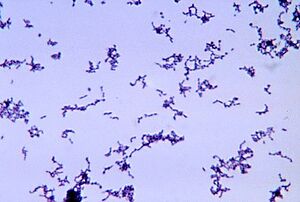Propionibacterium acnes: A Teenager’s Worst Nightmare Defined: Difference between revisions
| Line 31: | Line 31: | ||
<i>Propionibacterium acnes</i> is a gram-positive, fairly slow-growing aerotolerant bacterium. This bacteria is typically linked to the skin condition acne vulgris, commonly known as skin acne. This species is daily commensal and highly present on healthy skin epithelium. Little is detected on the skin of adolescents, specifically those pre-pubescent. This bacterium lives on fatty acids in sebum secreted by hair sebaceous glands in hair follicles. It can also be found in the gastrointestinal biome. | <i>Propionibacterium acnes</i> is a gram-positive, fairly slow-growing aerotolerant bacterium. This bacteria is typically linked to the skin condition acne vulgris, commonly known as skin acne. This species is daily commensal and highly present on healthy skin epithelium. Little is detected on the skin of adolescents, specifically those pre-pubescent. This bacterium lives on fatty acids in sebum secreted by hair sebaceous glands in hair follicles. It can also be found in the gastrointestinal biome. | ||
== | ==Skim Microbiome== | ||
Include some current research, with at least one figure showing data.<br> | Include some current research, with at least one figure showing data.<br>Microbiomes, in general, serve a greater purpose than living organisms just existing in their habitat. Through a combination of commensal species of microbes and their interactions with their habitat, environments are formed where the host and bacteria can adapt and regulate processes either to their advantage or negative effects of competition. The skin microbiome works identically. There is mass variability in the skin microbiome. As for microbes involved fungi, bacteria, viruses, and small arthropods contribute to this relationship [1]. In addition, the microbiome is much more complex than once thought. Past research has tended to focus only on pathogens and opportunistic pathogens rather than the entire spread of microbes in general (even “harmless” to human hosts). In addition to the variability of the microbes present in the skin microbiome, locations of the skin and their own environments are also variable from person to person. However, even in these differences, homeostasis between the microbiome and host is imperative for continued healthy interactions on the epithelium and avoids the occurrence of disease. | ||
The skin ecosystem is continuously variable in humidity, temperature, pH, and composition of antimicrobial peptides and lipids [1]. In addition, the frequency of hair follicles can also determine the production of sebaceous materials and eccrine and apocrine glands. With this variety of environments, it establishes a separate niche for microbes to fill and thrive in. The abundance of certain bacteria is dependent on these niches. | |||
<br> | <br> | ||
Revision as of 16:52, 11 April 2024
Section

By Megan Lydon
At right is a sample image insertion. It works for any image uploaded anywhere to MicrobeWiki.
The insertion code consists of:
Double brackets: [[
Filename: PHIL_1181_lores.jpg
Thumbnail status: |thumb|
Pixel size: |300px|
Placement on page: |right|
Legend/credit: Magnified 20,000X, this colorized scanning electron micrograph (SEM) depicts a grouping of methicillin resistant Staphylococcus aureus (MRSA) bacteria. Photo credit: CDC. Every image requires a link to the source.
Closed double brackets: ]]
Other examples:
Bold
Italic
Subscript: H2O
Superscript: Fe3+
Sample citations: [1]
[2]
A citation code consists of a hyperlinked reference within "ref" begin and end codes.
To repeat the citation for other statements, the reference needs to have a names: "<ref name=aa>"
The repeated citation works like this, with a forward slash.[1]
Section 1
Include some current research, with at least one figure showing data.
Every point of information REQUIRES CITATION using the citation tool shown above.
Propionibacterium acnes is a gram-positive, fairly slow-growing aerotolerant bacterium. This bacteria is typically linked to the skin condition acne vulgris, commonly known as skin acne. This species is daily commensal and highly present on healthy skin epithelium. Little is detected on the skin of adolescents, specifically those pre-pubescent. This bacterium lives on fatty acids in sebum secreted by hair sebaceous glands in hair follicles. It can also be found in the gastrointestinal biome.
Skim Microbiome
Include some current research, with at least one figure showing data.
Microbiomes, in general, serve a greater purpose than living organisms just existing in their habitat. Through a combination of commensal species of microbes and their interactions with their habitat, environments are formed where the host and bacteria can adapt and regulate processes either to their advantage or negative effects of competition. The skin microbiome works identically. There is mass variability in the skin microbiome. As for microbes involved fungi, bacteria, viruses, and small arthropods contribute to this relationship [1]. In addition, the microbiome is much more complex than once thought. Past research has tended to focus only on pathogens and opportunistic pathogens rather than the entire spread of microbes in general (even “harmless” to human hosts). In addition to the variability of the microbes present in the skin microbiome, locations of the skin and their own environments are also variable from person to person. However, even in these differences, homeostasis between the microbiome and host is imperative for continued healthy interactions on the epithelium and avoids the occurrence of disease.
The skin ecosystem is continuously variable in humidity, temperature, pH, and composition of antimicrobial peptides and lipids [1]. In addition, the frequency of hair follicles can also determine the production of sebaceous materials and eccrine and apocrine glands. With this variety of environments, it establishes a separate niche for microbes to fill and thrive in. The abundance of certain bacteria is dependent on these niches.
Section 3
Include some current research, with at least one figure showing data.
Section 4
Conclusion
References
Authored for BIOL 238 Microbiology, taught by Joan Slonczewski,at Kenyon College,2024
